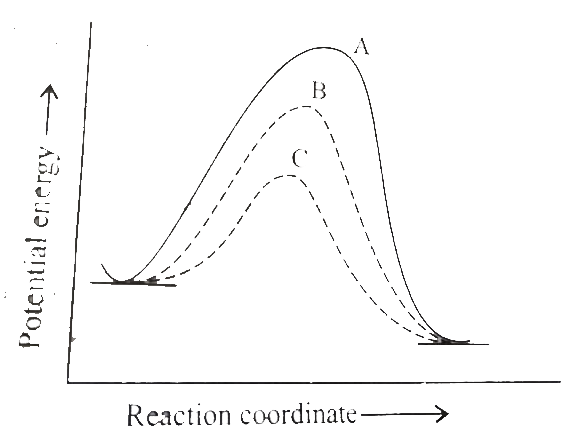Oxygen in absorbed by molten Ag, which is evolved on cooling and the silver particles are scattered, this phenomenon is known as:
silvering of mirror
spitting of silver
frosting of silver
hairing of silver
The correct Answer is:B
To solve the question regarding the phenomenon where oxygen is absorbed by molten silver (Ag) and is evolved upon cooling, leading to the scattering of silver particles, we can break it down step by step:
1. Understanding the Process:
- The question describes a situation where molten silver absorbs oxygen. This absorption occurs when silver is in a molten state, meaning it is heated to a point where it becomes liquid.
2. Cooling and Evolving Oxygen:
- As the molten silver cools, the absorbed oxygen is released. This release of oxygen can cause the silver particles to scatter, indicating a physical change in the structure of the silver as it solidifies.
3. Identifying the Phenomenon:
- The phenomenon described is known as "spitting of silver." This term refers to the behavior of molten silver when it absorbs a significant amount of oxygen and then releases it upon cooling.
4. Characteristics of Spitting of Silver:
- It is noted that molten silver can dissolve up to 22 times its volume of oxygen. When this oxygen is released, it can lead to the scattering of silver particles.
5. Controlling the Process:
- The spitting of silver can be controlled by adding deoxidants, such as charcoal, to the molten silver. Additionally, covering the surface of the molten silver with non-oxidizing agents or traces of metals like copper, bismuth, or zinc can help manage this phenomenon.
6. Conclusion:
- Therefore, the correct answer to the question is that the phenomenon described is known as "spitting of silver."
Final Answer:
The phenomenon is known as spitting of silver.
- The question describes a situation where molten silver absorbs oxygen. This absorption occurs when silver is in a molten state, meaning it is heated to a point where it becomes liquid.
- As the molten silver cools, the absorbed oxygen is released. This release of oxygen can cause the silver particles to scatter, indicating a physical change in the structure of the silver as it solidifies.
- The phenomenon described is known as "spitting of silver." This term refers to the behavior of molten silver when it absorbs a significant amount of oxygen and then releases it upon cooling.
- It is noted that molten silver can dissolve up to 22 times its volume of oxygen. When this oxygen is released, it can lead to the scattering of silver particles.
- The spitting of silver can be controlled by adding deoxidants, such as charcoal, to the molten silver. Additionally, covering the surface of the molten silver with non-oxidizing agents or traces of metals like copper, bismuth, or zinc can help manage this phenomenon.
- Therefore, the correct answer to the question is that the phenomenon described is known as "spitting of silver."
The phenomenon is known as spitting of silver.
Topper's Solved these Questions
- BOOK - VK JAISWAL ENGLISHCHAPTER - d-BLOCK ELEMENTSEXERCISE - ASSERTION-REASON TYPE QUESTIONS32videos
d-BLOCK ELEMENTS
- BOOK - VK JAISWAL ENGLISHCHAPTER - d-BLOCK ELEMENTSEXERCISE - SUBJECTIVE PROBLEMS6videos
d-BLOCK ELEMENTS
- BOOK - VK JAISWAL ENGLISHCHAPTER - CO-ORDINATION COMPOUNDSEXERCISE - LEVEL 2144videos
CO-ORDINATION COMPOUNDS
- BOOK - VK JAISWAL ENGLISHCHAPTER - ENVIRONMENTAL CHEMISTRYEXERCISE - ASSERTION-REASON TYPE QUESTIONS14videos
ENVIRONMENTAL CHEMISTRY
Similar Questions
The solution in which the light is not scattered by the particles is:
View Solution[A] : The obligate parasites can live only on dead hosts .
[R] : There are some organisms which grow and live together but each one is always harmed by the other . This phenomenon is known as antagonism .View Solution
Knowledge Check
- Question 1 - Select One
A point at which illuminated plant parts stop absorbing CO2 from their enviroment, is known as
ACO2 compensation pointBCO2 saturation pointCCO2 optimum pointDCO2 limiting point.
Which one does not evolve oxygen
View SolutionSubstances which alter the velocity of a reaction by mere presence, without undergoing any change in mass and compossition are termed catalyst and the phenomenon is known as catalysis
Which is incorrect for a catalyst?View SolutionSubstances which alter the velocity of a reaction by mere presence, without undergoing any change in mass and compossition are termed catalyst and the phenomenon is known as catalysis
According to the adsorption theroy of catalysis, the rate of reaction increases becauseView SolutionSubstances which alter the velocity of a reaction by mere presence, without undergoing any change in mass and compossition are termed catalyst and the phenomenon is known as catalysis
In homogenous catalytic reactions, there are three alternative paths A, B, and C (shown in figure). Which one of the following indicates the relative ease with which the reaction can take place?
 View Solution
View SolutionMolecules from which oxygen evolves during photosynthesis.
View SolutionA point at which illuminated plant parts stop absorbing CO2 from their environment , is known is
View SolutionPhenomenon of dissoluion of lead in ordinary water containing dissolved oxygen is known as
View Solution

